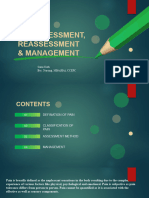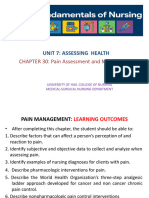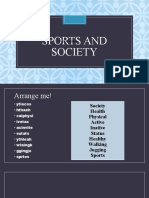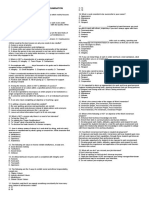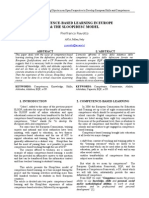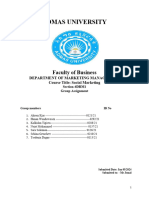220 Abstracts / Pain Management Nursing 21 (2020) 207e222
PURPOSE CONCLUSION
Opioids are commonly prescribed for pain, though long-term use can have Pain Assessment and Management are vital skills for nurses to possess
negative health consequences. Cannabis use has been linked to reduced while working with pediatric patients requiring complex care. The level of
opioid use, although reasons for cannabis use among adults using pre- pain expertise varies among newly hired nurses. A pain assessment and
scription opioids are unclear. The purpose of this study was to determine management orientation program is an effective method of improving
whether motivations for cannabis use differ between adults prescribed knowledge among new nurses.
opioids for persistent pain (PP) versus those receiving opioids as medica-
tion-assisted treatment for opioid use disorder (OUD) in a state with R6 Student Nurse Attitudes and Knowledge
legalized recreational and medical cannabis. Regarding Chronic Pain in the Older Adult
Catherine Sargent PhD, RN, BC, AOCNS. Gwynedd Mercy University
METHODS
The study received Institutional Review Board approval at the university of
Researchers report nursing students hold misconceptions related to ageism
the principal investigator. Adults prescribed opioids for OUD or PP and lack interest in both pain management and gerontology. The purpose of
completed surveys regarding cannabis use. A series of regression models this study was to investigate if there is a difference in degree of ageism plus
tested demographic differences and compared cannabis use motivations
knowledge and attitudes regarding chronic pain in the older adult in tradi-
among the two populations of interest using validated factors of the
tional, baccalaureate sophomore nursing students prior to and following
Marijuana Motives Measure (MMM) scale. ANOVAs and chi-square tests their second clinical experience. This study utilized a pre-test, post-test
calculated differences in other reported reasons for cannabis use among
repeated measures design to answer three research questions that were
adults with OUD and PP.
derived from the work of Krathwohl and the Theory on the Taxonomy for
RESULTS Affective Domain of Learning. Fraboni’s Scale on Ageism plus the Knowledge
Data from 243 participants were analyzed (OUD n¼139, PP n¼104). More and Attitudes Regarding Pain Survey were used for data collection. Data were
than half the sample (n¼122) reported current, daily cannabis use. Across analyzed using descriptive statistics, t-test, and chi square.
the sample, 67% reported pain as a motivation for cannabis use with no RESULTS
difference between OUD or PP populations. Adults with PP were more A total of 183 surveys were completed, 97 in the pre-clinical group and 86
likely to be older, female, and have higher levels of education (p <0.05). in the post-clinical group. The majority of participants were young, female,
Adults with PP were less likely to report “enhancement” motives for and Caucasian. Baseline scores on the KASRP ranged from 13 to 22 out of 31
cannabis use (p < 0.01), while adults with OUD were more likely to report questions answered correctly, with a mean of 18. The mean for the total
relief of drug withdrawal symptoms as a motivation for cannabis use (p < pre-clinical score on the FSA was 59.17. The post-clinical experience group
0.001). demonstrated an increase in pain knowledge and attitude as indicated by
CONCLUSIONS the increase in the score on the KASRP when compared to the pre-clinical
PP participants were less likely to use cannabis for euphoric effects or group There was a moderate degree of ageism, with little change over time
withdrawal purposes versus OUD participants. Both populations in FSA scores The total FSA scores as well as the three sub-factors of the
commonly reported cannabis use for pain. Further research should scale (Antilocution, Discrimination, and Avoidance) all had acceptable
determine whether and how cannabis can assist in reducing overall opioid Cronbach alpha levels.
usage for people with PP or OUD.
R7 Perceptions of Behavioral Pain Assessment Tools
R5 Assessing Pain Assessment and Management and Pain Outcomes in Non-verbal Patients: A Pilot
Knowledge among Newly Hired Nurses Survey
Linda B. Hurd MSN, CRNP, Theresa DiMaggio MSN, CRNP, Christi Strawley Kelly D. Allred PhD, RN-BC, CNE, Patrick Healy RN, BSN. University of
MSN, CRNP, Maureen Scollon-McCarthy MSN, CRNP, Ashley Bakke MSN, Central Florida
CRNP, Michele Bythrow MSN, CRNP, Carol Donner MSN. The Children's
Hospital of Philadelphia Very acute and critically ill patients are likely to experience significant
pain. A subset of these patients, due to their specific condition, may not be
verbal or communicative and thus unable to report their pain subjectively.
PURPOSE Behavioral pain assessment tools are a method of objectively measuring
This project is designed to determine if nurses starting their employment pain in patients who are unable to communicate. While the use of these
at our 546 bed pediatric institution have general knowledge related to pain tools has been shown to improve short- and long-term outcomes for pa-
assessment and management, as measured by taking a six-question pre- tients, there is lack of evidence as to nurses’ perceptions related to their
test on assessment and management of pain. Many of our patients expe- use. The purpose of this study is to investigate acute care nurses’ percep-
rience pain related to their condition. Pain assessment and management tions of the relationship between the use of behavioral pain assessment
are critical skills for nurses to possess when managing the complex pe- tools and pain outcomes in nonverbal patients. A total of 23 acute and
diatric patients receiving care in our hospital, as well as patients receiving critical care nurses participated in a survey designed to illicit their re-
care at our ambulatory centers. A Central Nursing Orientation is provided sponses related to the use of these tools. The survey asked multiple
to all new nurses including a session on pain assessment and management. perception-based questions related to pain assessment and management
This is a Quality Improvement project, however, we also submitted this in nonverbal patients including but not limited to, the importance of pain
project to our Institutional review board for review. We anticipate assessment, the frequency of use of behavioral pain assessment tools, the
approval shortly. use of pain scores in patient hand-off and education related to behavioral
METHODS pain assessment tools. Open ended questions were also posed inquiring
A six-question pre-test on Pain Assessment and Management is adminis- about perceptions of the effect of using behavioral pain assessment tools
tered to the nurses prior to the lecture. Nurses are informed that partici- on pain assessment and pain outcomes. Survey results indicated a majority
pation in this testing is voluntary and anonymous. The lecture includes a (82.6%, n¼19) of participants think the use of behavioral pain assessment
power point presentation, case studies as well as participation from the tools improves pain assessment and pain outcomes. It is perceived that use
nurses via questions and answers. Following the lecture, a post-test con- of these tools creates a thorough standardized assessment which allows
taining the same questions as the pre-test is administered to the nurses. for objective evaluation of pain and effective pain relief.
RESULTS R8 Preventing Post-operative Chronic/Persistent
68 nurses completed the pretest and 67 nurses completed the post-test. Pain Using Gabapentinoids
Summary statistics for the survey scores of the nurses at 2 time points: Ben Keck MSN, RN-BC. Covenant Children's Hospital
Pre-test: n¼68 nurses, M¼64.21, SD¼19.61. Post-test: n¼67 nurses, M¼
89.94, SD¼12.71. Both groups have minimum scores of 33 and maximum Postoperative pain is cited by twenty percent of patients attending pain
scores of 100. We plan to collect data on a total of 140 nurses. clinics as the cause of their chronic pain, it is reveled in other articles this



















